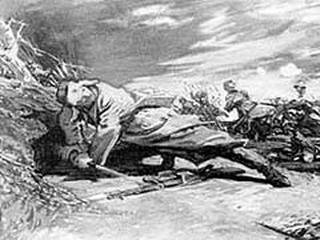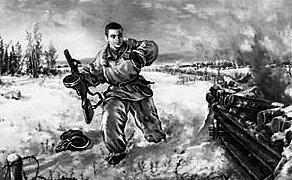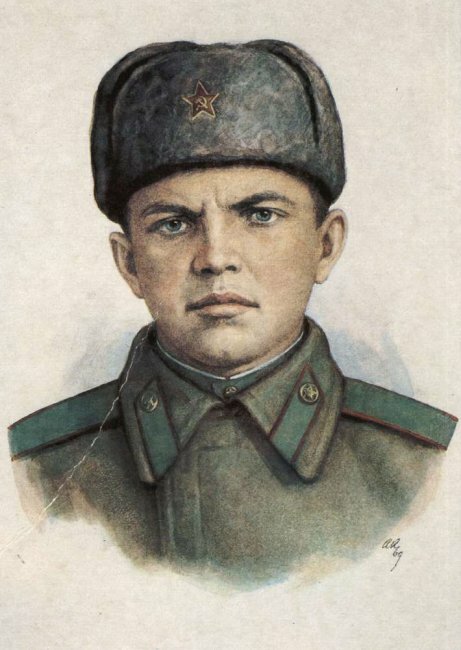Alexander Matrosov
Alexander Matrosov during the Second World War closed the enemy's bunker with his body, saving his comrades with his own life and giving his unit the opportunity to capture a strategically important bridgehead. This feat became a symbol of courage and military valor, fearlessness and love for the Motherland. A. Matrosov posthumously awarded the title Hero of the Soviet Union. September 8 1943 by order of the USSR Commissar of Defense, his name was given to the 254 Guards Rifle Regiment, and he was forever enlisted in the lists of the 1 Company.
Like any legend, the biography of Alexander Matrosov has two versions: official and real. First, remember the first one. Alexander Matveyevich Matrosov was born in Dnepropetrovsk. His father worked as a caster at the factory. Later, Sasha’s biography was “supplemented” by the fact that his father was a communist who died from a kulak bullet. Mother died, the boy had no relatives. He was on the street. I got to an orphanage somewhere in Ukraine, then I ended up in Russia, in the Ivanovo orphanage. Later - in the children's labor colony in Ufa. In the Red Army he was called up in September 1942, in October he was sent to the Krasnokholmsky Infantry School. Soon the cadets were sent to the Kalininsky front. In the army, the Sailors was from November 1942 of the year. He served in the 2-th separate infantry battalion 91-th separate Siberian volunteer brigade. JV Stalin (later 254-th Guards Rifle Regiment of the 56-th Guards Rifle Division). First, the brigade was in reserve, and then it was transferred under Pskov to the area of the Big Lomovaty boron. 22 February 1943, the 2 Battalion received the task of attacking an enemy stronghold in the area of the village of Chernushki and on the 25 anniversary of the creation of the Red Army at any price to take possession of it. The soldiers immediately came under heavy fire from three German machine guns in the bunker. Two of them suppressed the assault groups, but the third bunker continued to fire at the dell in front of the village. Attempts to silence him were unsuccessful. Then the Sailors himself volunteered to neutralize the firing point: he got to the embrasure from the flank and threw two grenades. The machine gun was silent, but when the fighters went on the attack, he came to life again. The sailors got up, rushed to the bunker, and with his body closed the embrasure. After the attack, comrades picked him up: he was lying about six meters from the burning bunker, there was no grenade, the automatic rifle was empty. The combat mission of the unit was completed. A few days later, Matrosov’s name became known throughout the country: his exploit was used by a casual journalist for a patriotic article. The regiment commander learned about the exploits from the newspapers. Going into battle, Matrosov gave a coherent letter addressed to Lida Kurganova, the girl he met before leaving for the front: "If I am destined to die, I would like to die like our general: in battle and facing west." His wish came true.
However, in this stories too many inaccuracies. Several discrepancies in dates and events make you think about the real picture. Firstly, the story about A. Matrosov is permeated with the heroics of the narration and the voluntariness of self-giving. But the one who served in the army for one day knows that any voluntariness is carried out only by order. Secondly, official historians have confused with the place of service and the date of its commencement. Only in January, Alexander Matrosov got into the 91 Pacific Komsomol Marine Brigade of the 6 Volunteer Rifle Corps named after J. Stalin. And with the date of death, frontline correspondents overdid it: he died on February 27, and wrote on 23. Why change the dates, explain, probably, it is not necessary even to those who slept on the lessons of history. Just to 23 February, Stalin by all means needed a heroic deed. And then - an orphan with a Russian surname, which was important during the war. Sailors was not the first to commit such an act of self-sacrifice, but it was his name that was used by propaganda to glorify the heroism of Soviet soldiers. Especially since he approached in all respects: 19-year-old Komsomol member, handsome, fighter, contemplating death, a real idol for future generations.
Who was actually the man who, more than 60 years ago, closed the enemy bunker with him? The unequivocal answer does not seem to exist. During the years of the "cold war", the West German magazine "Stern" argued that this feat was a falsification. Our compatriots also expressed their assumptions - one at first turned Matrosov into a “vagabond”, then into “a urkagan, a loafer, a rude, a parasite”. Another smeared the life of the hero with dirt. There is also an opinion that there was no Matrosov at all.
 However, there are other, more noteworthy versions. According to one of them, the father of the future hero was Matvey Matrosov, a wealthy peasant, dispossessed and sent to settle in the Kazakh steppes. “The son is not responsible for the father”, then the phrase “leader and teacher” was like to repeat. And the boy was in the Ivanovo orphanage, where he did not stay. At the age of twelve, the “homeless peasant son of A. M. Matrosov,” a “hare” who arrived by rail in Ufa, was captured by the police and placed in a children's labor colony. Later he became an assistant teacher, joined the Komsomol. However, for the affair with one of the senior pupils, Alexander was expelled from the Komsomol and dismissed from teaching work. He went to work at the plant, and at eighteen he volunteered for the Red Army. In the training regiment he proved himself very well, he was reinstated in the Komsomol, in October 1942 was sent to study at the Krasnokholmsky Infantry School. November 7 in a senseless attack of enemy positions, timed to coincide with the “anniversary of Great October Revolution”, the young fighter was wounded, left the battle himself and pulled out a seriously wounded comrade. The award was the medal "For Military Merit." He simply escaped from the medical battalion as soon as the wounds were allowed. The command of the regiment slapped the soldier ... and enrolled in reconnaissance. On the eve of the death Matrosov presented to the Order of the Red Star, which he did not have time to receive. He was crowned with the highest award - posthumously ...
However, there are other, more noteworthy versions. According to one of them, the father of the future hero was Matvey Matrosov, a wealthy peasant, dispossessed and sent to settle in the Kazakh steppes. “The son is not responsible for the father”, then the phrase “leader and teacher” was like to repeat. And the boy was in the Ivanovo orphanage, where he did not stay. At the age of twelve, the “homeless peasant son of A. M. Matrosov,” a “hare” who arrived by rail in Ufa, was captured by the police and placed in a children's labor colony. Later he became an assistant teacher, joined the Komsomol. However, for the affair with one of the senior pupils, Alexander was expelled from the Komsomol and dismissed from teaching work. He went to work at the plant, and at eighteen he volunteered for the Red Army. In the training regiment he proved himself very well, he was reinstated in the Komsomol, in October 1942 was sent to study at the Krasnokholmsky Infantry School. November 7 in a senseless attack of enemy positions, timed to coincide with the “anniversary of Great October Revolution”, the young fighter was wounded, left the battle himself and pulled out a seriously wounded comrade. The award was the medal "For Military Merit." He simply escaped from the medical battalion as soon as the wounds were allowed. The command of the regiment slapped the soldier ... and enrolled in reconnaissance. On the eve of the death Matrosov presented to the Order of the Red Star, which he did not have time to receive. He was crowned with the highest award - posthumously ...Versions are many, and among them another one stands out, very interesting. It was promoted by historians of Bashkortostan. Why exactly they? It’s really important for the Bashkir people and the small village of Kunakbaevo of the Uchalinsky District that the official recognition that Alexander Matrosov was called Shakiryan Mukhamedyanov is really important. The significance of his exploits will not diminish from this. But after Salavat Yulaev he will become the second national batyr of Bashkiria. It is assumed that the one who would later be called Matrosov was born in the family of Yunus and Muslim Yusupov in 1924. In the book of birth certificates, he is registered as Mukhamedyanov Shakiryan Yunusovich (named after his grandfather). When the mother died, the boy was no more than seven years old. They lived very poorly, and often Yunus, taking his son’s hand, walked around the courtyards to beg. Shakiryan did not know his native language very well - my father spoke more Russian, because it was more convenient to walk to beg. With the emergence of the third wife of Yunus, Shakiryan left home. It is difficult to say where he went after that: the papers of all the children's homes of the Bashkir ASSR of the beginning of the 1930s have not survived. It is possible that he got into the detreem-distributor along the line of the NKVD, from where he was sent to Melekess of the Ulyanovsk region. There his first tracks appeared as Sashki Matrosov. Among the street kids there were their own laws, and one of them said: if you are not Russian, you will be kept away from you in every possible way. Therefore, getting into children's homes and colonies, the teenagers tried to change their native names and surnames to Russians. Later, in the Ivanovo regime colony, Sashka told how he called Dnipropetrovsk his hometown, although he had never been there. In the colony he had a few nicknames. One of them is Shurik-Shakiryan (apparently, someone knew his real name). The second is the Bashkir. After graduating from school in 1939, Matrosov was sent to Kuybyshev to the car-repair plant, from where he escaped. The last time in his own Kunakbaevo Shakiryan was seen in the summer of 1939. He finally became Russified and called himself Alexander Matrosov - no one asked why. In Kuibyshev, he was taken to the police, accusing "of violating the passport regime." Again, Matrosov’s traces surfaced in the autumn of 1940 in Saratov. According to the documents, the people's court of the Frunzensky district condemned him under article 192 of the Criminal Code of the RSFSR for two years in prison. He was found guilty of the fact that, despite the subscription given by him about leaving the city of Saratov at 24 for an hour, he continued to reside there. Sailors sat in a labor colony in old Ufa. At the end of September 1942, in the group of other recruits, he ended up in the Krasnokholmsky military infantry school near Orenburg. There Matrosov was taken to the Komsomol.
The life of this man is covered with lies. The feat was timed to the 25 anniversary of the Red Army, and Alexander was a fighter of the elite 6 volunteer infantry corps to them. Stalin - these two circumstances played an important role in the creation of the state myth. For decades, no one thought that the events described were contrary to the laws of nature. It is now theoretically and practically proven that the feat in the form in which the press presented it could not take place. After all, it’s impossible to close the machine-gun embrasure with your body. Even one rifle bullet, which fell into the hand, inevitably knocks a person down. A machine-gun burst at close range will drop any, even the heaviest body, from the embrasure. The propaganda myth, of course, is not able to repeal the laws of physics, but is able to make them forget for some time. How did events really develop? Consider the most reliable version of what happened.
 As the front-line newspaper wrote, Matrosov's body was found not on the embrasure, but in the snow before the bunker. Probably, he was able to climb onto the roof of the firing point and tried to shoot the German machine-gun crew through the vent, but was killed. Throwing the corpse to release the outlet, the Germans were forced to cease fire, and during this time the comrades of Matrosov overcame the sweep. The body could also fall in such a way that closed the sector of shelling to the Germans. The soldier’s feat really did, but he didn’t rush to the embrasure: this way of fighting enemy bunkers is absurd.
As the front-line newspaper wrote, Matrosov's body was found not on the embrasure, but in the snow before the bunker. Probably, he was able to climb onto the roof of the firing point and tried to shoot the German machine-gun crew through the vent, but was killed. Throwing the corpse to release the outlet, the Germans were forced to cease fire, and during this time the comrades of Matrosov overcame the sweep. The body could also fall in such a way that closed the sector of shelling to the Germans. The soldier’s feat really did, but he didn’t rush to the embrasure: this way of fighting enemy bunkers is absurd.Circumstances could be somewhat different. The embrasure of the bunker is not a window from which the barrel of the machine gun protrudes (in such a case it would be easily vulnerable to fragments and bullets), but a deep funnel-like loophole that goes deep into the thick walls of the shelter. The machine gun is in the chamber and fires through the hole in the funnel, extending outward the sector of its attack. Rushing into the embrasure of the bunker (and not “to the embrasure”), the scout turned into a traffic jam. In principle, his body could be pushed out by a long pole in the garrison’s household, but this took some time. Consequently, the heroic deed of our hero was not an act of despair or a consequence of a blind impulse - in the last moments of his life he was able to assess the situation and make the only possible decision.
There is another option. When they failed to throw the grenades into the embrasure of the bunker (they exploded nearby, without causing harm), the Sailors got closer and got into the “dead zone”. Having spent the ammunition, he was in a difficult situation: he could not crawl away (he would have fired in the crossfire), and the Germans could have captured him. Therefore, he approached the embrasure and rushed not at her, but on the top of the machine gun. Leaning on with his whole body, the soldier pushes him into the ground, preventing the Nazis from firing. Then there are two possible variants of events: first, the Germans pull Matrosov through the embrasure inside, shoot and carry the body out, the second shoot it right through the doorway and drop the body off the embrasure. The episode of the struggle and the release of the machine gun takes some time, so necessary for our fighters.
Who was this man, what is his real name, we, apparently, will never know. And is it really important? After all, regardless of whether he was a Russian or a Bashkir, the son of a communist or a dispossessed peasant, first of all he was and remains a hero - contrary to the opinion of skeptics.
All versions of the secret identity Matrosov documented. But since in our state they always liked clarity and pathos, some of them are absurd, puzzling and completely legitimate irony: two museums presented the original Komsomol hero ticket as an exhibit. Only one thing was written: "I went to the firing point of the enemy", on the other - "to the battle".

Information